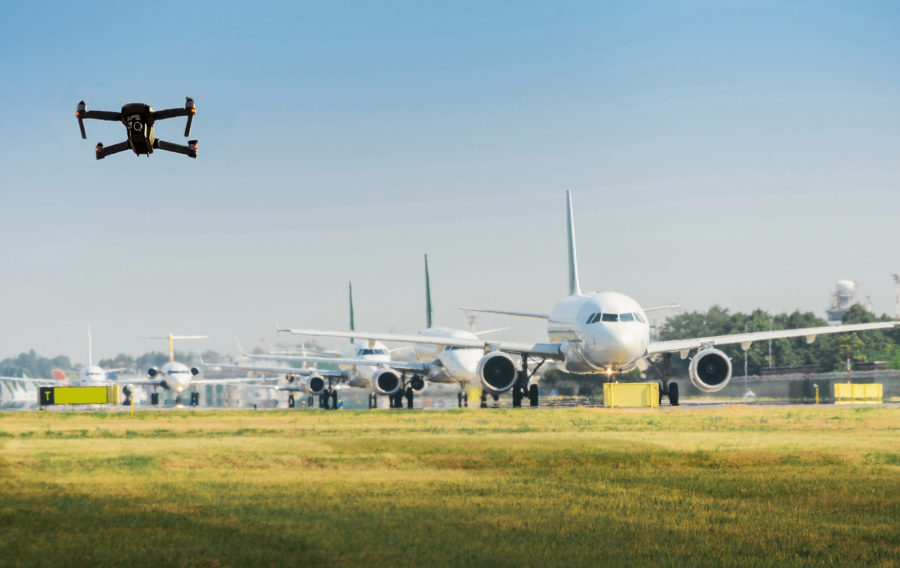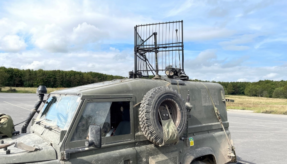
With the security threats from hostile drones evolving at pace, it’s critical that the UK’s military and security forces benefit from the very latest technology to stay ahead of the curve. Here, we take a look at how the Ministry of Defence is seeking solutions to counter these threats through one of DASA’s latest competitions.
The introduction of Unmanned Air Systems (UAS), or drones as they are more commonly known, has been one of the most significant technological advances of recent years and represents a paradigm shift in military capability. The threat has evolved rapidly, leading to the use of hostile improvised UAS in several roles in current overseas theatres of operation.
Closer to home, we have seen drones create significant security challenges at prisons as well as at major UK airports – bringing chaos and disruption to the lives of ordinary people.
Reducing or eliminating the risk posed by a hostile UAS requires a range of capabilities: detecting the presence of a drone, locating it, identifying it and its objective, and then supporting or deploying measures (effectors) to mitigate its effect.
Each of these activities is dependent on the previous stage in the ‘kill chain’, and they must work quickly and effectively together in order to provide overall protection. Consequently, countering UAS is reliant on a broad range of specialisations, from technologies, policies, procedures and tactics to training and logistics.
The Defence and Security Accelerator (DASA) has launched a competition that seeks innovative proposals that can develop the technology required to counter UAS and integrate together to form a capable system.
The competition is the latest stage in the Defence Science and Technology Laboratory’s (Dstl) ongoing research programme into countering UAS, which has been running for ten years. The programme has included extensive research, testing and evaluation of counter-UAS technology currently employed by the Ministry of Defence, including the landmark series of ‘Bristow’ trials with industry in 2013, 2015 and 2018.
Dstl’s Principal Engineer, David Lugton, explains: “Hostile UAS is a challenging threat in many different ways and requires cutting-edge technology and well-thought-out system approaches to counter it effectively. Through this competition we are looking to inspire and develop a range of solutions to mitigate the threat posed by UAS now and in the future.”
Among the technologies being sought by DASA are those that can simultaneously detect and track multiple threats, with minimal human monitoring, and against a broad spectrum of UAS types.
The small physical size, relatively low altitude and low speed associated with Unmanned Aerial Vehicles (UAVs) are factors that pose a significant detection challenge in themselves, but these difficulties are compounded by other key attributes that make such UAS a very difficult air defence target. These include the operator’s location being some distance away, meaning that in some scenarios disabling the operator could be the most effective countermeasure.
Another issue is the potential for drones to operate on evolving radio bands. There is the possibility that the UAV could be operating on a unique frequency or, at the very least, be difficult to identify from the rest of the radio background.
Also, the sensors on commercial off-the-shelf and state-sponsored drones are capable of detecting and tracking objects, in some cases autonomously, at ranges that can prevent awareness of their presence.
There is understandable concern, moreover, that the threats posed by UAVs will only increase as their capability is enhanced. Future drones will be faster and more difficult to detect, in addition to having a greater operational range. They will carry larger, more sophisticated payloads, incorporate advanced artificial intelligence (AI)-based navigation and situational awareness systems, and will use emerging communication methods.
DASA’s competition has three challenges, with proposals required to meet at least one of them:
The first challenge – Next-Generation Counter-UAS Technology – is focused on providing robust cost-effective security from the threat of drones that offers significant improvement over current systems.
There are a number of current technology solutions that provide UAS detection or mitigation options. They are effective in certain scenarios but already have some key limitations. While all of these limitations cannot be resolved within a single challenge, DASA’s aim for now is to focus on reducing the manpower burden of current sensor solutions and reducing the collateral risk posed by deploying an effect against a target UAS.
The second challenge focuses on DASA’s recognition that no one sensor can provide wide area detection, tracking and identification (DTI) across all Counter-UAS threat scenarios and environments and that robust C-UAS DTI solutions will require the use of a number of different types of sensor, potentially distributed across the battlespace or around the vulnerable asset.
Similarly, the choice of effector will be guided by target vulnerability and a number of contributory factors. Moreover, for some scenarios, there may be a requirement to deploy a range of effectors in a ‘lines of defence’ model where increasingly aggressive attack modes are used as the target approaches.
Integrating these components in an intelligent and flexible way has proved to be a complex and difficult challenge, and most current integration attempts are less effective. Accordingly, DASA is seeking integrated solutions that enable a highly automated, scalable, distributed and affordable C-UAS sensor and effector network.
The third and final challenge – Countering Future UAS Systems – looks at developing capability to detect and mitigate threats from drones acting autonomously in highly congested airspace, both singly and as a swarm.
With the rapid advances in AI / machine-learning sensing and navigation, future UAS are likely to have a high degree of autonomy. Such capability becomes even more challenging when incorporated within a swarm.
The challenge differentiates between a dumb swarm and a smart swarm. A dumb swarm is made up of multiple UAS with discrete UAVs, each separately flown to a predetermined common goal via GNSS Waypoint or Terrain navigation on autopilot, or by human operators in real time. In-flight activity is coordinated only during pre-mission (human) planning and cannot readily respond to a changing situation without additional operator intervention, except through limited pre-programmed responses.
A smart swarm is an adaptive group of UAVs operating within a self-organising network as a single semi-autonomous UAS. It has the ability to assess a situation (including the actions or loss of other UAVs) and respond without operator intervention. A smart swarm will automatically adjust individual UAV roles to maintain the overarching central mission aim.
The competition is phased, with the first phase to deliver proof of concept of proposed advanced technology components and subsystems that meet the challenges and which could be developed and integrated into full Counter-UAS systems.
Phase 1, which will deliver proof of concept of the proposals, will be worth approximately £800,000 and is scheduled to take place from July 2019 to March 2020. The total funding for the competition is expected to be at least £2 million, split over multiple phases.
If you would like to join our community and read more articles like this then please click here.







